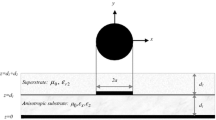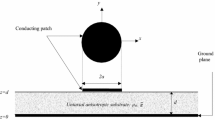Abstract
In this paper, radiation characteristics of the perfectly superconducting, or an imperfectly conducting rectangular microstrip, which is printed on isotropic or uniaxial anisotropic substrate are investigated using a Fourier transforms domain in conjunction with the stationary phase method. The effects of uniaxial anisotropy on the resonant frequency, half-power bandwidth, and radiation patterns are investigated as the function of anisotropy ratio values of substrate materials. It is found that the resonant frequency and the half-power bandwidth are affected significantly by the superconductivity property of the patch. Further results show that a thin superconductor patch has a significant effect on the radiation pattern. Results are compared with previously published data and are found to be in good agreement.







Similar content being viewed by others
References
Barkat, O., & Benghalia, A. (2010). Synthesis of superconducting circular antennas placed on circular array using a particle swarm optimisation and the full-wave method. Progress in Electromagnetics Research B, 22, 103–119.
Khan, T., De, A., & Uddin, M. (2013). Prediction of Slot-Size and Inserted Air-Gap for Improving the Performance of Rectangular Microstrip Antennas Using Artificial Neural Networks. IEEE Antennas and Wireless Propagation Letters, 12, 1367–1371.
Bose, T., & Gupta, N. (2012). Design of an aperture-coupled microstrip antenna using a hybrid neural network. Microwaves, Antennas and Propagation, IET, 6(4), 470–474.
Gürel, C. S., & Yazgan, E. (2010). Analysis of annular ring microstrip patch on uniaxial medium via Henkel transform domain immittance approach. Progress in Electromagnetics Research M, 11, 37–52.
Benkouda, S., Messai, A., Amir, M., Bedra, S., & Fortaki, T. (2014). Characteristics of a high T c superconducting rectangular microstrip patch on uniaxially anisotropic substrate. Physica C: Superconductivity, 502, 70–75.
Boufrioua, A., & Benghalia, A. (2006). Effects of the resistive patch and the uniaxial anisotropic substrate on the resonant frequency and the scattering radar cross section of a rectangular microstrip antenna. Aerospace Science and Technology, 10(3), 217–221.
Liu, X., Shi, X., Ke, J., & Wang, H. (2014). Radiation properties of microstrip patch antenna covered with an anisotropic dielectric layer and a plasma sheath. Optik - International Journal for Light and Electron Optics, 125(6), 1770–1774.
Mandal, K., & Sarkar, P. P. (2013). A compact high gain microstrip antenna for wireless applications. AEU - International Journal of Electronics and Communications, 67(12), 1010–1014.
Koziel, S., Ogurtsov, S., Zieniutycz, W., & Sorokosz, L. (2014). Expedited design of microstrip antenna subarrays using surrogate-based optimization. IEEE Antennas and Wireless Propagation Letters, 13, 635–638.
Aneesh, M., Ansari, J. A., Singh, A., & Sayeed, S. S. (2014). Analysis of microstrip line feed slot loaded patch antenna using artificial neural network. Progress in Electromagnetics Research B, 58, 35–46.
Chebbara, F., Benkouda, S., & Fortaki, T. (2010). Fourier transform domain analysis of high Tc superconducting rectangular microstrip patch over ground plane with rectangular aperture. Journal of Infrared, Millimeter, and Terahertz Waves, 31(7), 821–832.
Messai, A., Benkouda, S., Amir, M., Bedra, S., and Fortaki, T.: ‘Analysis of High Superconducting Rectangular Microstrip Patches over Ground Planes with Rectangular Apertures in Substrates Containing Anisotropic Materials’, International Journal of Antennas and Propagation, 2013.
Khedrouche, D., & Benghalia, A. (2013). Modeling the superconducting effects on resonance and radiation characteristics of a cylindrical-rectangular microstrip antenna covered with a dielectric layer. Journal of Computational Electronics, 12(2), 297–305.
Benmeddour, F., Dumond, C., Benabdelaziz, F., & Bouttout, F. (2010). Improving the performances of a high TC superconducting circular microstrip antenna with multilayered configuration and anisotropic dielectrics. Progress in Electromagnetics Research, 18, 169–183.
Bedra, S., Bedra, R., Benkouda, S., & Fortaki, T. (2014). Full-wave analysis of anisotropic circular microstrip antenna with air gap layer. Progress in Electromagnetics Research M, 34, 143–151.
Fortaki, T., Djouane, L., Chebara, F., & Benghalia, A. (2008). Radiation of a rectangular microstrip patch antenna covered with a dielectric layer. International Journal of Electronics, 95(9), 989–998.
Fortaki, T., Khedrouche, D., Bouttout, F., & Benghalia, A. (2004). A numerically efficient full-wave analysis of a tunable rectangular microstrip patch. International Journal of Electronics, 91(1), 57–70.
Aouabdia, N., Belhadj-Tahar, N.-E., Alquie, G., & Benabdelaziz, F. (2011). Theoretical and experimental evaluation of superstrate effect on rectangular patch resonator parameters. Progress in Electromagnetics Research B, 32, 129–147.
HFSS: High Frequency Structure Simulator, Ansoft Corp, (2011).
Pozar, D. M. (1987). Radiation and scattering from a microstrip patch on a uniaxial substrate. IEEE Transactions Antennas and Propagation, 35(6), 613–621.
Richard, M. A., Bhasin, K. B., & Claspy, P. C. (1993). Superconducting microstrip antennas: an experimental comparison of two feeding methods. IEEE Transactions on Antennas and Propagation, 41(7), 967–974.
Da Silva, S.G., d’Assuncao, A.G., & Oliveira, J.D.R.S. (1999). Analysis of high Tc superconducting microstrip antennas and arrays, Microwave and Optoelectronics Conference, SBMO/IEEE MTT-S, Rio de Janeiro, pp. 243–246.
Fortaki, T., & Benghalia, A. (2004). Efficient analysis of the far field pattern of rectangular microstrip patch using the stationary phase method, The 16th international conference on microelectronics, ICM 2004 Proceedings, pp. 278–281.
Author information
Authors and Affiliations
Corresponding author
Rights and permissions
About this article
Cite this article
Bedra, S., Fortaki, T., Messai, A. et al. Spectral Domain Analysis of Resonant Characteristics of High Tc Superconducting Rectangular Microstrip Patch Printed on Isotropic or Uniaxial Anisotropic Substrates. Wireless Pers Commun 86, 495–511 (2016). https://doi.org/10.1007/s11277-015-2941-x
Published:
Issue Date:
DOI: https://doi.org/10.1007/s11277-015-2941-x




